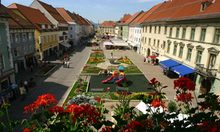Worth seeing
First appearing in written records in 1131, the church is late Romanesque in its basic design, while its current appearance is that of a late Gothic steeple church. Its current exterior dates back to a fundamental restoration after a fire in 1829. The west wall contains several funerary monuments dating from the 15th to the 18th century.
The main square, which measures about 200 by 30 meters, contains a pest stele from 1715/16 and two fountains (“Vogelweide-Brunnen” and “Schüsselbrunnen”).
Also worth a closer look is the late Gothic Rathaus on the main square, a three-storey, six-axis Gothic structure with an ogee arch and very elaborate façade. The abbey church “Our Dear Lady”, located southwest of the former citizens’ hospital, was originally documented in 1323 as the church of a Clarissee cloister founded by Konrad von Auffenstein and his wife Diemut. It is an interesting sight to see.
The main railway station of St. Veit was built between 1911 and 1913. It is a long, one to two storey Late Historic building, whose prestigiously designed main hall has a steep roof with decorative gable, and a protruding bell tower with ornamental mouldings and an octagonal lantern mount.



